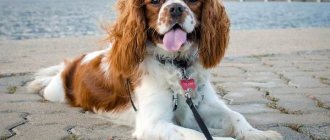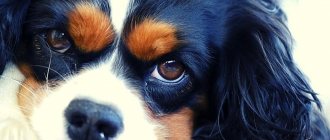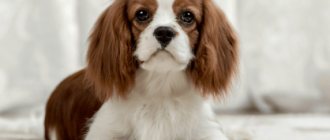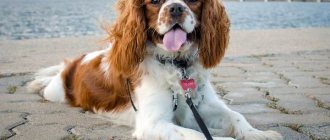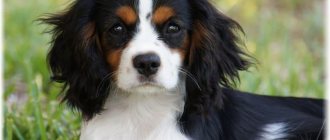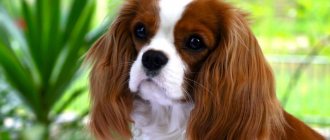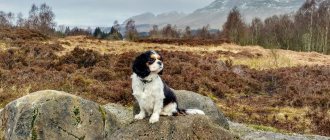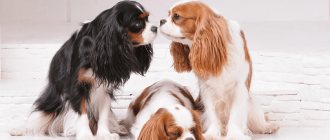Spaniel, cocker spaniel. Briefly about the breed.
Common features.
Spaniels are a group of gun dogs whose main purpose was to search for game and retrieve it after shooting.
Some types of spaniels were universal; in addition to birds, they hunted rabbits, foxes and ungulates. Nowadays, more and more spaniels are kept as family pets, given their elegant appearance, friendly disposition, intelligence, loyalty, courage and small size. Spaniels of all varieties remain unrivaled despite the ever-changing fashion for pets. They are easy to train, completely versatile, ideally suited for living next to a person, both in an apartment and in their own home. But this ancient breed of dog has been a hunting dog at all times and has retained its qualities to this day. In addition to the Cocker Spaniel, there are 8 more subspecies of this group, among them the Russian Hunting Spaniel, which is not recognized by the FCI, as well as a decorative variety - the Cavalier King Charles Spaniel (English Toy Spaniel). The most characteristic, common features of these dogs are long hanging ears, prone to diseases without proper care, a good-natured look of expressive eyes and hair - shorter on the back, croup, front side of the limbs and head and longer in the feathering area - skirt and pants, paws. The body of these dogs is square or close to square. The head is proportional to the body, has a rounded skull and a rectangular muzzle. The tail is long and straight, carried on the line of the back or below; in some representatives of the breed it is docked. The coat of spaniels is usually quite thick, silky and soft. Origin.
It is generally accepted that spaniels were bred in Spain in the early Middle Ages, from where they came to other European countries. There are also Celtic and Roman hypotheses.
Spaniel varieties.
The most common subspecies of this dog breed in Russia are English and American Cocker Spaniels, Russian Hunting Spaniels, King Charles Spaniels and Cavalier King Charles Spaniels.
Let's talk about them. American Cocker Spaniel.
Homeland: USA, 19th century.
The American Cocker Spaniel was bred around 1880; the ancestor of the English hunting cocker spaniel is considered. This is the smallest representative of the hunting group of dogs. The dog's height is from 36 to 38 cm, weight is 11-13 kg. The hair on the head is short and soft; on the body - medium length with dense undercoat; on the ears, chest, belly and limbs the hair is thicker, softer and longer. The texture of the coat is silky, close-lying, straight or slightly wavy. The color is varied. They are affectionate and loyal, well trained, not aggressive, and get along with children. They live up to 14 years and may suffer from heart disease, joint disease, and epilepsy. English cocker spaniel
Homeland: Great Britain, 19th century.
Officially recognized in 1920. This is a real hunting breed, bred to hunt birds - woodcocks. Nowadays they are mostly companion dogs. This is a medium-sized spaniel: height 38-41 cm, weight 13-15 kg. There are mini varieties. The coat is smooth, silky, not hard, not wavy or curly, and not too abundant, unlike the “Americans”. The paws, skirt and hind legs above the hocks are well covered with hair. The color is very diverse: black, any solid color. The English Cocker Spaniel is considered an ideal dog for a novice owner; it gets along well with children, feels great in the city, and can be trained well with kindness and food stimulation. Aggressive training methods are not recommended; reverse aggression is possible. They live up to 15 years and may suffer from eye problems and behavioral problems. Russian hunting spaniel.
This is the only gundog breed of Russian origin from the 19th century, used for hunting birds and hares.
The breed is recognized by the RKF, but not recognized by the FCI. The breed standard was adopted in 1951. This is a small dog, 38-42 cm tall and weighing 15-18 kg. The coat color is black, brown or red, as well as two- and three-color. The dog is balanced, but active; long walks are necessary. King Charles Spaniel.
According to the FCI, they belong to group 9, section 7 - English toy spaniels. Homeland: Great Britain, British Isles. The breed owes its name to King Charles (Charles II Stuart 1630-1685). These are small dogs, 25-27 cm tall, weighing 4-6 kg, with a small, somewhat flattened muzzle and upturned nose, large, wide-set, slightly bulging eyes. The coat is long, silky and comes in black and tan, ruby and white and red (Blanheim) colors. The dog has a cheerful disposition, but does not need much physical activity outside the home, is affectionate, obedient, and loyal to other animals and children. Life expectancy is up to 12 years, there are problems with the heart and eyes.
Cavalier King Charles Spaniel
. This dog breed belongs to FCI Group 9, Section 7 - English Toy Spaniels. These are decorative dogs, very similar to the King Charles Spaniel, except that their muzzle is not short and upturned, but elongated, and their eyes are set closer and not so protruding. Originally from Great Britain, these spaniels were bred to protect the owners’ feet from the cold that reigned in castles or in carts, as well as to attract fleas, giving the owner a chance to protect himself from the plague. They serve people exclusively as companions. The standard dog is 30-33 cm tall and weighs 5-9 kg. This dog has a thick, soft, silky coat that comes in Blenheim, tri-color, ruby, and black and white. They are very calm, loving to curl up at the feet of their owners, but despite this they are excellent runners. These dogs have been proven to have a calming effect on most people and are extremely beneficial for the elderly and anyone suffering from loneliness (empty nest syndrome), they are not averse to playing with children and are great at traveling. These are healthy and clean pets, but can suffer from heart disease. Life expectancy 9-11 years
Why is it unique?
The Cavalier King Charles Spaniel has a long, but not curly, coat. The standard allows only light waves throughout the body. Part of the coat is characterized as decorative (“decoration”), which is located on the limbs and tail. It feels soft and fluffy to the touch.
The Cavalier's coat is not trimmed. Show dogs are not given haircuts.
The problem area is the spaniel's paws. They become heavily overgrown with hair, and this is assessed negatively by the judge. Paws that are cut too short are also not successful in the ring. The dog's paws should look neat and natural, as if no one had ever trimmed the pet.
Grooming, haircut, trimming of a Russian hunting spaniel
According to the established exhibition rules for the Russian Spaniel, cutting and processing of the coat is permissible, but it should be inconspicuous and smooth. It is strictly forbidden to cut the hair on the underside of the tail, but it is better not to touch it at all, the back of the front and hind legs, or the lower abdomen. It is not advisable to trim the hair on the ears, chest and neck.
Considering that the hair on the head of many Russian spaniels has the shape of a cap or tuft, and this should not be in the breed standards, excess hair is removed by stripping, achieving smoothness and tight adherence to the skull. A similar practice can be used above the ears, giving the impression that the dog's ears are at eye level, as they should be. In the neck and back area, stripping and carding are also carried out so that the fur lies close to the skin and does not stick out in different directions. Excess hair needs to be removed between the paw pads and around the ear canal.
Types of spaniel haircuts, photos
Here are the most common types of haircuts for cocker spaniels. The top row is for the American cocker, the bottom row is for the English cocker. Haircuts 1 and 5 are for show class dogs, the rest are pet haircuts. Each of the hairstyles can successfully highlight the individual beauty of the dog. Of course, a spaniel in show grooming is especially irresistible, but difficult to care for; pet haircuts are more practical.
How much does grooming cost | Spaniel haircut? Spaniel haircut price.
The cost of cutting a spaniel at any pet salon, including Mishka's grooming salon, depends on the size of the dog, the condition of the coat at the time of coming to the pet salon (presence of tangles) and the services you want to receive.
Approximate cost of a grooming complex with a haircut for a spaniel = 2800 rubles, a complex with trimming and edging haircut = 3500 rubles. The complexes, in addition to cutting and trimming/carding, include bathing and drying, combing, trimming nails, removing excess hair from paw pads and ears, cleaning ears and glands. Removing tangles and cutting the hair around the dog’s toes or “poodle paws”, as in photo 4, is not included in the price!
See the full Price list for grooming services and current Promotions and Discounts for grooming
Grooming
Cavalier King Charles Spaniel grooming can be divided into show and pet grooming.
Exhibition
If the dog is to perform in the ring, the owner must ensure that the spaniel's coat is as natural as possible.
Grooming takes place approximately 2 weeks before the expected exhibition, so that the hairs (if the paws are cut) have time to grow slightly and take on their natural shape.
The Cavalier King Charles Spaniel is not fully clipped. The coat remains long and silky. Shortly before the performance, the pet must be washed, dried and thoroughly combed. The master removes all tangles and gives the fur a special shine.
Pet grooming and haircut
Pet grooming allows for hygienic cutting (in the groin area, between the paw pads, chest and belly). It simplifies the care of the dog's coat and visually gives it a neat appearance. The coat on the belly and limbs of the Cavalier Spaniel can be lightly trimmed. As a rule, the master shortens it as much as the dog owner requires. You can completely get rid of the “decorations”, or you can make a neat haircut with a border.
The fur on the belly is either completely shaved off, or the groomer makes a “pseudoskirt” for the pet. He removes the fur and leaves it only on the sides and front, creating a skirt only visually. Pseudoskirts significantly reduce the time it takes to groom a dog. In addition, it reduces the risk of tangles appearing on the belly, which is a sensitive area for any dog.
Grooming, trimming English Cocker Spaniel
Correct grooming procedures: hygienic grooming (see above), stripping and carding, bathing and combing, light edging and filing.
Grooming practices used in pet grooming: machine cutting. If you are trimming a spaniel
, then do this before swimming, using trimming powder and rubber gloves/finger pads. It is ideal if you use the hand stripping technique (plucking dead guard hairs with your hands), taking into account breed standards, skeletal structure and muscle lines (see pic). And also, without fail, carding is used (combing out the dead undercoat) so that the fur subsequently fits tightly to the body. Procedures are carried out in the head, neck, back, croup, hips (see figure). If, after trimming and bathing, the wool in the indicated areas continues to bristle, then you can thin it out as it grows using thinning scissors or a special attachment on the machine, lifting the wool with a comb.
If you are cutting a spaniel
, then do it in the same way as trimming and, preferably, in the direction of hair growth. Carding after a haircut won't hurt either.
Whatever grooming technique you choose, do not forget that the transition from short to long hair should be imperceptible! Please note that in show grooming the hair on the back of the front paws is kept natural, while on the front of the front paws the hair should be short. On the back of the thighs the hair should hang down but be separated from the tail. On the head and muzzle, the hair should be short and close to the skin. If there is overgrowth, then the muzzle is trimmed with a clipper, and the long hair on the head is stripped or also removed with a clipper. On the throat, the hair is removed short in the shape of a U. The ears are trimmed on the outer side to the top 1/3, on the inside - the hair is removed from the ear canals and about 1/2 of the upper part of the ear.
Keeping an elderly pet
Particular attention is paid to older dogs. They tolerate hygiene procedures worse. Grooming becomes more difficult mentally and physically. An elderly pet has either joint diseases or problems with cardiovascular organs and stress is contraindicated for him. Therefore, grooming an old dog should be done quickly and as carefully as possible.
The Cavalier King Charles Spaniel loses its former greatness with age. Their fur loses its shine and becomes curly. An older spaniel usually has his coat completely shaved off so as not to expose the pet to the stress of combing. It is very important to choose an experienced groomer who can get an elderly spaniel in order as quickly as possible.
Description of the breed
The Cavern King Charles Spaniel dog has the following exterior parameters:
- The weight of a dog, depending on its gender, ranges from 5 to 8 kg.
- Height also depends on gender and ranges from 24 to 36 cm.
- The dog can live up to 13-14 years.
- The muzzle is wedge-shaped.
- Lips pressed tightly against each other.
- Correct bite.
- The ears are long, like those of most representatives of the spaniel breed, and covered with elongated hair.
- The area of transition from the skull to the muzzle is not clearly expressed.
- The body has a concavity in the region of the ribs.
- The back is straight.
- The Cavalier King Charles Paniel's tail is sometimes docked. If this is not done, then they have a proportional length in comparison with the rest of the body.
- The fur in the paw area forms a feathering.
- The dog's fur is thick and does not show curl.
Bathing
Experienced breeders do not recommend washing the Cavalier King Charles Spaniel more than once a month. This is associated with the risk of dry skin, which entails a number of problems with the coat. The water should be warm, but not hot, so that the dog does not get thermal burns.
Before bathing, the pet must be combed. For bathing procedures, it is recommended to use shampoos intended only for dogs. They will not cause irritation to the skin and mucous membranes, which cannot be said about human hygiene products. After bathing, the dog must be thoroughly dried and brushed.
Cut it yourself or leave it to a professional
Haircut for a Maltese (Maltese) like a puppy
There are several factors that are necessary for a successful haircut. Every professional groomer takes them into account.
Spaniel after a hygienic haircut
The owner must evaluate his capabilities before starting work with his own hands:
- hygiene and sanitation must be carefully observed;
- you need professional equipment: from simple tools, scissors and combs to clippers and trimmers;
- it is necessary to ensure calm behavior of the animal;
- You will need to find a huge amount of time for each haircut.
Important! Some owners prefer to cut their hair themselves, but it is very important to prepare properly. The workplace must be properly decorated.
Claws, ears and teeth
Cavalier King Charles Spaniel, nails trimmed every 2 weeks. To do this, use a special small nail clipper. Your pet needs regular ear cleaning – once a week. Cotton swabs or disks are moistened with ear lotion and wiped over the dog's ears.
To prevent your teeth from suffering from tartar, you need to brush them at least once every 2 weeks. Brushing too frequently carries a high risk of gum injury. To prevent tartar, you can give your spaniel fresh tomatoes.
BREEDER'S ADVICE
To begin with, it is worth understanding that people from whom you can purchase a puppy can be divided into breeders (breeders, breeders) and simply sellers. Naturally, there are all sorts of intermediate options.
The breeder has a goal: to achieve a certain level in his breeding. This is not the goal of one day or month, but of many years of work. Each litter from a breeder is a step in a strictly defined direction with the expectation of specific results, and from each (every!) litter the breeder is ready to leave a puppy in the kennel for the next steps forward. Sometimes it works, sometimes it doesn't. The breeder takes care of his females - he does not untie them too early and does not breed them too often. The breeder monitors the health of the dogs and removes from breeding those who for some reason do not meet his requirements. The breeder is proud of his veterans living in the nursery. The breeder has a name, so, on the one hand, he will be proud of his dogs and his achievements, and on the other hand, he will avoid anything for which he might be ashamed. The breeder has come for a long time, his reputation has been built over the years.
The seller has a different goal: he breeds dogs to sell puppies. Often jumps from rock to rock. Uses breeders while they are able to give birth, and begins breeding them quite early. The name, the traditions of the kennel, the dynasty of his dogs are not particularly important to him. He works for results here and now - the puppy must be sold quickly and profitably. Minimal attention is paid to health checks of producers. What could be behind this, I think, is clear and without explanation.
Characteristic signs of sellers: advertising puppies without the names of the parents, the name of the breeder, the name of the kennel; loud definitions for a small puppy in advertisements - “show class”, “vip”, “exclusive”, “elite”; willingness to allow you to reserve a specific puppy at a very early age, when it is not yet clear what he will turn out to be; sales through intermediaries; sending the puppy to a new home before two months. These are all things that any beginner can notice and should be wary of.
The breeder, on the contrary, has all information about dogs and puppies open. The maximum rating he gives to a small puppy is “promising at the time of sale.” The breeder will offer you to reserve a specific puppy only after he understands that he will not leave him in a kennel or under a kennel, and when he already knows approximately which puppy needs which family. A self-respecting breeder will never sell puppies through intermediaries or from other people's homes; contact with the buyer is important to him, and he is responsible for the puppy until it is transferred to the family that he considered suitable for the baby.
As a rule, breeders do their job well, that is, they keep dogs, get and raise beautiful puppies, and sellers do their job: they advertise and sell).
Naturally, I did not list all the differences and did not dwell in detail on the intermediate options. But, I think, this is enough to be puzzled and analyze the offers that come across.
Combing wool
The Cavalier King Charles Spaniel's coat needs to be brushed on a regular basis. Every week the procedure is carried out 2-3 times. Ignoring it will cause a large number of tangles. Some tangles cannot be combed and must be removed with scissors, which spoils the appearance of the pet.
For combing, you can use a slicker brush and a small comb. First, the coat is combed from the base with a slicker brush to remove dead hairs. The comb is used for long hair, and it also partially helps to sort out tangles. Sometimes craftsmen use a furminator.
The comb should pass freely through the hairs. Only then is the dog considered brushed.
Feeding
It is important for the owner to remember that the small Toy Spaniel is prone to allergic reactions and overeating. The breed can rapidly gain excess weight. Many people feel that their pet is malnourished because the portions for the Cavalier Spaniel are negligibly small. This becomes a reason to increase the volume of feed.
Breeders claim that the breed is more suited to feeding on a natural basis. Among the cereals they highlight oatmeal, buckwheat and rice. They are rich in minerals and vitamin B. Meat is a source of protein. For the Toy Spaniel, lean varieties of beef, lamb or horse meat are more suitable. The meat must be boiled.
You can give your pet fermented milk products: kefir, yogurt, cottage cheese. It is not advisable to offer sour cream - it is too fatty for the breed. The source of vitamins are vegetables and fruits. The Cavalier King Charles Spaniel is allowed to be given apples, carrots, parsley, and cabbage leaves. For variety, they can be stewed with kefir or meat.
A toy spaniel should not be fed spicy, fatty or sweet foods. This can lead to the development of serious gastrointestinal diseases. If the owner decides to buy ready-made food for the pet, ingredients such as wheat and chicken should be avoided. These are strong allergens in the breed.
Under no circumstances should you pamper your pet with pieces from your own table. As a rule, our food is extremely harmful for dogs, as it contains a lot of fat, spices and salt. It is best to buy special treats for dogs. They are manufactured taking into account their physiology and do not contain anything harmful. An example would be Country Treats, TitBit, Green Cousin and so on.
